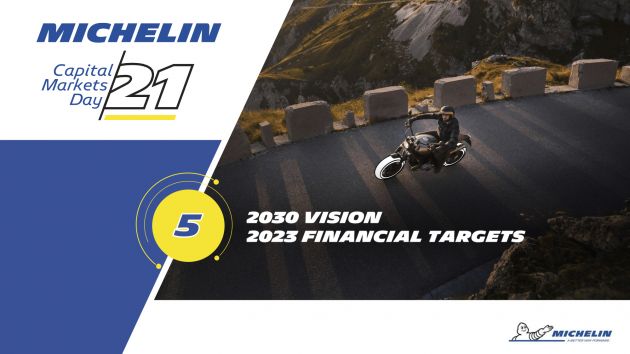Michelin in Motion sustainability strategy – up to 30% of sales from non-tyre business segments targeted
The Michelin Group has outlined its strategy towards 2030, dubbed Michelin in Motion, along with the outlining of initial targets set for 2023 as a 10-year vision with a three-year implementation plan, said CEO Florent Menegaux.
The group’s ambitions for 2030 were also outlined, which is based on 12 indicators encompassing environmental, social, societal and financial performance.
In terms of environmental ambition towards 2030, Michelin has set out to shift towards clean energy as well as reducing its energy consumption. These will go towards a 50% reduction of CO2 emissions compared to the group’s output in 2010 under Scope 1, which is defined as emissions generated by sources owned or controlled by the company, and Scope 2, from the generation of energy that is purchased and consumed by the company.


A similar goal has been set for logistics, in which Michelin aims for a 15% reduction in CO2 emissions by 2030 compared to 2018. Meanwhile, the group also aims for 70% of its suppliers in its supply chain to have ‘ambitious, science-based reduction targets by 2024. Across its various scopes of manufacturing, logistics and supply chain, Michelin is aiming for carbon-neutrality by 2050.
Michelin has set out to attain ‘full circularity’ of its products, or to reach 100% use of sustainable raw materials in by 2050, and to reach 40% by 2030. As of 2020, the tyres used in MotoGP – for which Michelin is the sole supplier – already feature a 40% composition of renewable materials, said the company.
Costs resulting from negative externalities such as carbon emissions, along with water and solvent use are being calculated, and the Michelin Group has committed to reducing these by around 10%, from around 330 million euros (RM1.62 billion) to 300 million euros (RM1.48 billion) in 2023, it said.
In terms of profit, Michelin aims for an average increase in sales of 5% per year between 2023 and 2030, and the year 2023 was mentioned as a more immediate timeline as this is when market recovery is expected, from the downturn resulting from the pandemic, the CEO said.
The group aims to derive 20% to 30% of sales from non-tyre business segments such as services and solutions, flexible composites, medical devices, metal 3D-printing as well as hydrogen mobility.
In services and solutions, the group aims to enlarge its portfolio of fleet solutions through the application of smart objects and from the value of of data collected through these methods.


Products in the non-tyre sector, such as in the market of flexible composites – conveyors, belts, seals, coated fabrics and the like – is hoped to grow significantly as well, through the group’s strategy of mergers and acquisitions as well as incubating new businesses.
The medical devices segment also represents a growth opportunity for the group, while the group’s development of unique expertise in support of AddUp, a metal additive manufacturing joint venture between Michelin and Fives which produces tailored solutions for manufacturers in various industries.
Here, the group aims to reach 100 million euros (RM492 million) in sales and break even by 2023, and plans to exceed 500 million euros (RM2.46 billion) in sales by 2030.
In terms of passenger vehicle and motorcycle tyre trends, volume is expressed as a percentage of the 100% baseline from 2019, which is the year before the pandemic. The OE (original equipment) world market for passenger car tyres is expected to see a 0.5% compounding annual growth rate (CAGR) from 2019 to 2023, while the replacement world market is expected to record a 0.7% CAGR over the same period.
The OE and replacement market for passenger car tyres combined sees the greatest expected growth for the 19-inch diameter sizes and larger. For this size segment, Michelin is targeting a 12% margin for 2023.
As before, 2019 is measured as the 100% baseline, and the 19-inch and larger segment remained flat through 2020, and this segment is expected to see a CAGR of 14% in 2023. The 18-inch segment is expected to see CAGR of 10%, while the 17-inch and smaller segment is expected to decrease by 10% from 2019 levels in 2023.
In the two-wheeler tyre segment, the worldwide motorcycle leisure and commuting market is expected to see a 3% CAGR between 2019 and 2023. Also expressed as a baseline of 100 units in 2019, the market shrank 10% last year due to the pandemic, and is expected to rebound to 98% of 2019 levels by the end of this year. This is attributed to an expected 10% increase in the use of bicycles and scooters by 2030, according to Michelin.
The post Michelin in Motion sustainability strategy – up to 30% of sales from non-tyre business segments targeted appeared first on Paul Tan's Automotive News.
from Paul Tan's Automotive News
Read The Rest:paultan...








Post a Comment